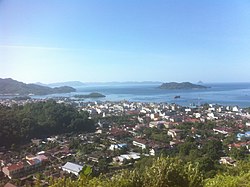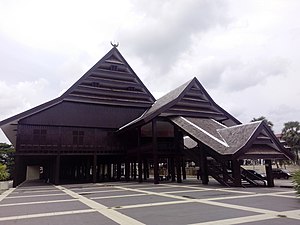Pusatoka: Difference between revisions
No edit summary |
No edit summary |
||
| Line 38: | Line 38: | ||
| established_title = | | established_title = | ||
| established_date = 1311 CE | | established_date = 1311 CE | ||
| founder = [[King | | founder = [[King Gumelar II. of Batu]] | ||
| seat_type = | | seat_type = | ||
| seat = | | seat = | ||
| Line 115: | Line 115: | ||
=History= | =History= | ||
==Early settlements== | ==Early settlements== | ||
The history of settlements in the bay of Pusatoka probably traces back to the first humans to arrive on the Kapulakan Archipelago but volcanic activity up to the 13th century destroyed most of those early structures leaving only a very small archeological record. This same volcanic activity is also generally regarded as the one of the major factors for the construction of stilt houses by the kapulakans, a tradition that is kept alive to | The history of settlements in the bay of Pusatoka probably traces back to the first humans to arrive on the Kapulakan Archipelago but volcanic activity up to the 13th century destroyed most of those early structures leaving only a very small archeological record. This same volcanic activity is also generally regarded as the one of the major factors for the construction of stilt houses by the kapulakans, a tradition that is kept alive to this day. Its generally assumed that by the time the [[Batu Monarchy|Batu]] unified the islands under their rule Pusatoka already was the biggest settlement in the Archipelago. | ||
==Batu-period== | |||
After the first king of the Batu kingdom, King [[Gumelar I.]] already made Pusatoka his base of operations during the [[Wars of Unification (Kapulaka)|unification wars]]. As he died soon after having unified the different tribes it became the role of his son [[Gumelar II.]] to expand the settlement and finally make it his capital in 1215. Under the rule of Gumelar II. the town was expanded from being mostly located on stilts to also include land settlements, including temples and especially the [[Royal palace of Pusatoka]].[[File:Tamalate Palace of Gowa Kingdom.jpg|left|thumb|300px|Reconstruction of the Royal Batu Palace in Pusatoka, nowadays the [[National Heritage Museum (Kapulaka)|National Heritage Museum]]]] | |||
=Politics= | =Politics= | ||
Revision as of 23:06, 17 April 2023
This article is incomplete because it is pending further input from participants, or it is a work-in-progress by one author. Please comment on this article's talk page to share your input, comments and questions. Note: To contribute to this article, you may need to seek help from the author(s) of this page. |
Pusatoka
ᮕᮥᮞᮃᮊᮧᮒᮃ | |
|---|---|
 View on the city center of Pusatoka from the inner of Poeok | |
| Founded by | King Gumelar II. of Batu |
| Government | |
| • Body | Pusatoka City Council |
| • Mayor | Botak Mainaky (Kapulakan People's Party) |
| Area | |
| • Total | 104.7 km2 (40.4 sq mi) |
| Elevation | 15 m (49 ft) |
| Population (2022) | |
| • Total | 109,437 |
| • Density | 1,000/km2 (2,700/sq mi) |
| Demonym | Pusatokan |
| Postal Code | 101 |
| Website | putasoka.gov.kl |
Pusatoka (Kapulakan:ᮕᮥᮞᮃᮊᮧᮒᮃ) is the oldest and largest city of Kapulaka and its capital. It was founded as a trade settlement during the Batu period and steadily grew since then. Pusatoka is both the political and economic centre of Kapulaka while simultaneously being home to roughly one third of Kapulakas population. Next to its function as national capital Pusatoka is also the capital of Poeok, the state it is located in.
History
Early settlements
The history of settlements in the bay of Pusatoka probably traces back to the first humans to arrive on the Kapulakan Archipelago but volcanic activity up to the 13th century destroyed most of those early structures leaving only a very small archeological record. This same volcanic activity is also generally regarded as the one of the major factors for the construction of stilt houses by the kapulakans, a tradition that is kept alive to this day. Its generally assumed that by the time the Batu unified the islands under their rule Pusatoka already was the biggest settlement in the Archipelago.
Batu-period
After the first king of the Batu kingdom, King Gumelar I. already made Pusatoka his base of operations during the unification wars. As he died soon after having unified the different tribes it became the role of his son Gumelar II. to expand the settlement and finally make it his capital in 1215. Under the rule of Gumelar II. the town was expanded from being mostly located on stilts to also include land settlements, including temples and especially the Royal palace of Pusatoka.
